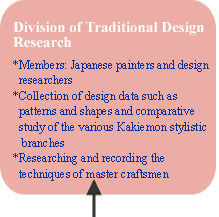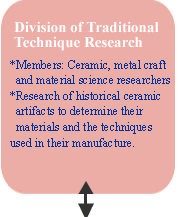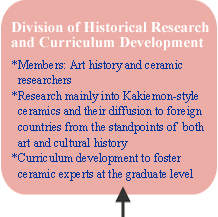 |
| Kakiemon-style ceramics with their bright multicolored (especially
red) overglaze painting on a milk-white body of porcelain were first
created in 1643 (the 20th year of Kanei in the Edo Period). We are
proud to be the home of this traditional cultural asset that is
known throughout the world. Kakiemon-style ceramics have not only contributed
to the development of the Japanese ceramic world, but also promoted
the development of Meissen ceramics and had a great influence on the
development of the ceramic culture of Europe. However, much of the
history of Kakiemon-style ceramics is yet to be uncovered. |
 |

|
The
program of the Kakiemon-style Ceramic Art Research Center will be
staffed by members of the Graduate School of Fine Arts and the Graduate
School of Enginneering. The study of Kakiemon porcelain will be divided
into the following three divisions.
1.Division of Traditional Design Research
2.Division of Traditional Technique Research
3.Division of Historical Research and Curriculum Development.
The research data generated by the COE program will be used to develop a curriculum
for our new graduate school for specialists in ceramic art.
This program will delve into issues involving the production of ceramics,
both as art and as industry. The study of world trends will help foster
specialists with a masterfs technique and artistic sense, in addition
to a top-notch theoretical background. This process will raise the level
of traditional Japanese craft arts. |
THE PROGRAM OF
"THE KAKIEMON-STYLE
CERAMIC ART RESEARCH CENTER" |
| Executive Director: SAGO, Takashi |
|
|
|
 |
 |
 |
 |
 |
 |
 |
|
|